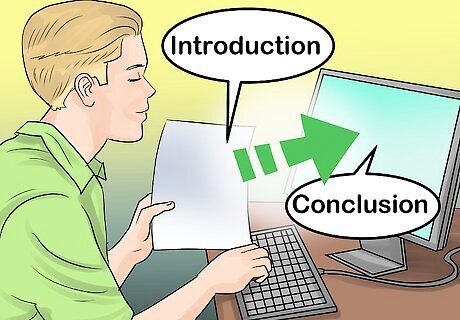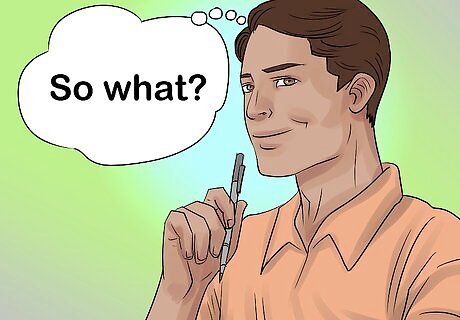
views
Reworking Your Thesis Statement

Rephrase your thesis statement. Avoid repeating your thesis statement as it appears in your introduction. This will seem redundant and show a lack of creativity on your part. Instead, rephrase the thesis statement so it appears differently in your conclusion. This will show that you have considered your thesis statement based on the rest of your essay and feel confident enough to rephrase it. Change the language and word choice in the original thesis statement. For example, maybe your original thesis statement was, “Though there are elements of tragedy in Shakespeare’s A Midsummer Night’s Dream, the structure, themes, and staging of the play fall into the genre of comedy.” You may then rephrase your thesis statement by shifting around some of the language in the original and by using a more precise word choice. For example, the rephrased thesis statement may be, “While there are tragic moments in Shakespeare’s A Midsummer Night’s Dream, the structure, themes, and staging of the play fit within the genre of comedy.”

Revise your thesis statement. Another option is to revise your thesis statement to be more clear, making deeper edits to it. Go back to your introduction and read your thesis statement again. Then, keep your thesis statement in mind as you read over your body paragraphs. Consider whether your thesis statement still feels relevant to your essay, or if it could be revised. Then, make adjustments to it so it better reflects your essay as a whole. For example, maybe your original thesis statement was, “Though there are elements of tragedy in Shakespeare’s A Midsummer Night’s Dream, the structure, themes, and staging of the play fall into the genre of comedy.” You may then revise it to better reflect your essay as a whole, “While tragic events do occur in Shakespeare’s A Midsummer Night’s Dream, the three-act structure, the themes of magic and dreams, as well as the farcical staging of the play indicate that it fits in the genre of comedy.” Keep in mind if you make major revisions to your thesis statement, it should only be done to reflect the rest of your essay as a whole. Make sure the original thesis statement in your introduction still compliments or reflects the revised thesis statement in your conclusion.

Place the thesis statement at the beginning of the conclusion. Start the conclusion with your rephrased or revised thesis statement. This will set the tone for your conclusion and show that you are connecting your conclusion back to the rest of your essay. You can then use the revised thesis statement to build the rest of your conclusion. You do not need to put “In conclusion,” “In summary,” or “To conclude” before your thesis statement to start the conclusion. This can feel too formal and stilted. Instead, start a new paragraph and launch right into your rephrased thesis statement at the beginning of the conclusion.
Writing the Middle Section of the Conclusion

Use the language and tone in your introduction. The middle section of your conclusion should be three to five sentences long. It should broaden the scope of your essay, borrowing the language and tone you have established in your introduction. Read over your introduction to get a sense of the tone and word choice. Pull certain phrases or terms you like from your introduction and rephrase them in your conclusion. This will make the conclusion feel like part of the essay as a whole. For example, you may have a sentence about how the staging of the play affects the genre of the play in your introduction. You could then rephrase this sentence and include it in your conclusion. If you read over your introduction and realize some of your ideas have shifted in your body paragraphs, you may need to revise your introduction and use the revisions to then write the middle section of the conclusion.

Repeat themes and images from the rest of the essay. You can also draw on themes and images that appear in the introduction or body of your essay and include them in your conclusion. Perhaps there is a particular image or scenario from the literary text that you responded to in the body section of the essay and want to include in your conclusion. Maybe there is a specific theme that comes up in the body section that you want to reiterate in your conclusion. For example, maybe you focus on the theme of magic in Shakespeare’s A Midsummer Night’s Dream in the body section of your essay. You can then reiterate the theme of magic by using an image from the play that illustrates the magical element of the text.

Put in a relevant quote from the literary text. Including a relevant quote from the literary text in your conclusion can also make it stronger and more effective. Perhaps there is a quote that you like but could not find space for in your body paragraphs. Or maybe there is a quote that feels like a summation of the focus of your essay as a whole. Use the quote to support your thesis statement and your claims in the essay. For example, if your essay focuses on how the theme of love in Shakespeare’s A Midsummer Night’s Dream, you may include a quote from the text that illustrates this theme.

Answer the question, “so what?” Think about why someone would care about what you are talking about in your essay and why the focus of your essay is important. Answering the question “so what?” can help you generate interesting things to finish your essay within the conclusion. For example, if you are writing an essay about Harper Lee's To Kill A Mockingbird, you may answer the question “so what?” by thinking about how and why Harper Lee's novel discusses issues of race and identity in the South. You could then use your response in the conclusion of the essay.

Summarize your essay. As part of your conclusion, you can also summarize your essay in one concise sentence. Avoid rehashing the details of your essay or simply listing the things you discussed in your essay. This can come across as redundant. Instead, focus on the key highlights in your essay and connect them back to your thesis statement. This way, you can show that the points discussed in your essay are relevant to your topic. For example, you may summarize your essay by noting, "An analysis of scenes between white characters and African-American characters in the novel, as done in this essay, make it clear that Lee is addressing questions of race and identity in the South head-on."

Do not include new information. Do not include new information or brand new insight in your conclusion. This will only confuse your reader and make your essay feel imbalanced. The conclusion should explore ideas already present in your essay, not introduce brand new ones.
Wrapping Up the Conclusion

Finish with a powerful image or detail from the text. Coming up with a good last sentence for your literary essay can be a challenge. One option is to use a powerful image or detail from the literary text that will be compelling for the reader. The image or detail should relate to the focus of your essay and reiterate your thesis statement. For example, if the focus of your essay is the theme of magic in the text, you may end with an image for the text that includes a magical element that is important to the main character.

End with a simple, straightforward sentence. Write the last sentence that is composed mostly of one-syllable words, making it simple and straightforward for your reader. Having a simple, to the point last sentence will ensure it has impact and stays with the reader. Read over your last sentence and remove any words that seem unnecessary or confusing. Simplify the last sentence of your conclusion so it is concise and to the point.

Set your essay within a larger context. Another way you can wrap up your conclusion is to refer your essay to a larger issue or a contemporary context. Think about how themes or ideas in your essay might relate to a larger issue in literature or a contemporary issue in the media. This can be a good way to make your essay feel relevant to now. For example, you may connect an essay about Harper Lee's To Kill A Mockingbird to modern issues around African-American rights in America. Avoid making overblown statements in the conclusion in an attempt to sum up your thoughts. Connecting your essay to a larger context is fine. Trying to connect your essay to vague ideas like “world suffering” or “the wage gap” will only confuse your reader and weaken your conclusion.

Edit the conclusion before submitting the essay. Once you are done with the conclusion, read it over to check for any spelling, grammar, or punctuation errors. Read the conclusion out loud to ensure it is well organized and flows well; you can even have someone else read it if you have time and it would be helpful, with the thesis statement upfront and a strong final line. Make sure the tone and language of the conclusion match the tone and language in the rest of the essay.




















Comments
0 comment